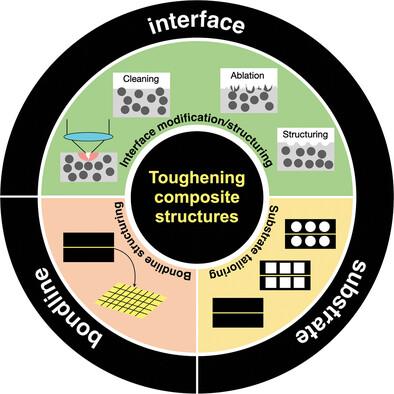当前位置:
X-MOL 学术
›
Adv. Mater.
›
论文详情
Our official English website, www.x-mol.net, welcomes your
feedback! (Note: you will need to create a separate account there.)
Harnessing Extrinsic Dissipation to Enhance the Toughness of Composites and Composite Joints: A State-of-the-Art Review of Recent Advances
Advanced Materials ( IF 27.4 ) Pub Date : 2024-11-20 , DOI: 10.1002/adma.202407132 Gilles Lubineau, Marco Alfano, Ran Tao, Ahmed Wagih, Arief Yudhanto, Xiaole Li, Khaled Almuhammadi, Mjed Hashem, Ping Hu, Hassan A. Mahmoud, Fatih Oz
Advanced Materials ( IF 27.4 ) Pub Date : 2024-11-20 , DOI: 10.1002/adma.202407132 Gilles Lubineau, Marco Alfano, Ran Tao, Ahmed Wagih, Arief Yudhanto, Xiaole Li, Khaled Almuhammadi, Mjed Hashem, Ping Hu, Hassan A. Mahmoud, Fatih Oz

|
Interfaces play a critical role in modern structures, where integrating multiple materials and components is essential to achieve specific functions. Enhancing the mechanical performance of these interfaces, particularly their resistance to delamination, is essential to enable extremely lightweight designs and improve energy efficiency. Improving toughness (or increasing energy dissipation during delamination) has traditionally involved modifying materials to navigate the well-known strength-toughness trade-off. However, a more effective strategy involves promoting non-local or extrinsic energy dissipation. This approach encompasses complex degradation phenomena that extend beyond the crack tip, such as long-range bridging, crack fragmentation, and ligament formation. This work explores this innovative strategy within the arena of laminated structures, with a particular focus on fiber-reinforced polymers. This review highlights the substantial potential for improvement by presenting various strategies, from basic principles to proof-of-concept applications. This approach represents a significant design direction for integrating materials and structures, especially relevant in the emerging era of additive manufacturing. However, it also comes with new challenges in predictive modeling of such mechanisms at the structural scale, and here the latest development in this direction is highlighted. Through this perspective, greater durability and performance in advanced structural applications can be achieved.
中文翻译:

利用外在耗散提高复合材料和复合接头的韧性:最新进展的最新综述
接口在现代结构中起着至关重要的作用,其中集成多种材料和组件对于实现特定功能至关重要。增强这些界面的机械性能,特别是它们的抗分层性,对于实现极轻的设计和提高能源效率至关重要。提高韧性(或增加分层过程中的能量耗散)传统上涉及对材料进行改性,以驾驭众所周知的强度-韧性权衡。然而,更有效的策略包括促进非局部或外在能量耗散。这种方法包括延伸到裂纹尖端以外的复杂退化现象,例如长距离桥接、裂纹碎裂和韧带形成。这项工作在层压结构领域探索了这种创新策略,特别关注纤维增强聚合物。这篇综述通过提出从基本原理到概念验证应用的各种策略,强调了巨大的改进潜力。这种方法代表了集成材料和结构的重要设计方向,在新兴的增材制造时代尤其重要。然而,在结构尺度上对此类机制进行预测建模也带来了新的挑战,这里强调了这个方向的最新发展。从这个角度来看,可以在高级结构应用中实现更高的耐用性和性能。
更新日期:2024-11-20
中文翻译:

利用外在耗散提高复合材料和复合接头的韧性:最新进展的最新综述
接口在现代结构中起着至关重要的作用,其中集成多种材料和组件对于实现特定功能至关重要。增强这些界面的机械性能,特别是它们的抗分层性,对于实现极轻的设计和提高能源效率至关重要。提高韧性(或增加分层过程中的能量耗散)传统上涉及对材料进行改性,以驾驭众所周知的强度-韧性权衡。然而,更有效的策略包括促进非局部或外在能量耗散。这种方法包括延伸到裂纹尖端以外的复杂退化现象,例如长距离桥接、裂纹碎裂和韧带形成。这项工作在层压结构领域探索了这种创新策略,特别关注纤维增强聚合物。这篇综述通过提出从基本原理到概念验证应用的各种策略,强调了巨大的改进潜力。这种方法代表了集成材料和结构的重要设计方向,在新兴的增材制造时代尤其重要。然而,在结构尺度上对此类机制进行预测建模也带来了新的挑战,这里强调了这个方向的最新发展。从这个角度来看,可以在高级结构应用中实现更高的耐用性和性能。


















































 京公网安备 11010802027423号
京公网安备 11010802027423号